the place where Paleontology and Paleoanthropology meets Philately
Comoros Islands
Dinosaurs, prehistoric animals, prehistoric human on stamps of Comoros Island
| << previous country | back to index | next country >> |
Contents:
- Country overview
- Philately of Comoros Islands
- Official stamps of Comoros Islands related to Paleontology
- Other stamps to consider
- References
- Acknowledgements
The Comoros, officially the Union of the Comoros, is a sovereign archipelago island nation in the Indian Ocean located at the northern end of the Mozambique Channel off the eastern coast of Africa between northeastern Mozambique and northwestern Madagascar. Other countries near the Comoros are Tanzania to the northwest and the Seychelles to the northeast.
Its capital is Moroni, on Grande Comore. At 1,660 km2 (640 sq mi), excluding the contested island of Mayotte, the Comoros is the third-smallest African nation by area. The population, excluding Mayotte, is estimated at 798,000. As a nation formed at a crossroads of different civilizations, the archipelago is noted for its diverse culture and history.
The archipelago was first inhabited by Bantu speakers who came from East Africa, supplemented by Arab and Austronesian immigration. It became a French colony in the 19th century before becoming independent in 1975. The Union of the Comoros has three official languages – Comorian, Arabic and French. As of 2008 about half the population lives below the international poverty line of US$1.25 a day. [R1]
According to Michel catalogue the first stamp of Comoros was issued in 1950. The definitive set of that shows some local landscapes.
The first Paleontology related stamp of Comoros issued in 1954 with living fossil fish: Latimeria chalumnae. [R2]
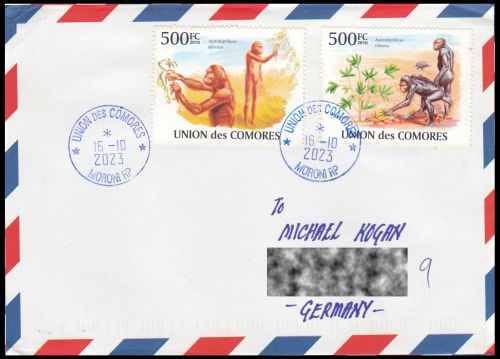 |
| Regular letter from the Union of the Comoros, with stamps of prehistoric humans from 2010, sent to Germany in 2023. |
Latimeria chalumnae, is the West Indian Ocean coelacanth (Latimeria chalumnae),
sometimes known as gombessa, African coelacanth, or simply Coelacanth, is one of two extant species of coelacanth, a rare order of vertebrates more closely related
to lungfish and tetrapods than to the common ray-finned fishes.
The fish was first discovered around the Comoro Islands, Madagascar, and Mozambique
in the western Indian Ocean.
This coelacanth was once thought to be evolutionarily conservative, but discoveries have shown there to be initial morphological diversity.
It has a vivid blue pigment and is the better known of the two extant species.
[R3] [A1]
Usually, Comoros issues 10 to 50 stamps per year, but there are several years when they issued many more stamps, for example:
1977, 1989, 1992, 1998, 2010, 2011: over 100 stamps per year,
1976, 1978, 1979, 1988, 1999: over 200 stamps per year.
2009: almost 800(!) stamps, including many Paleontology related stamps. [R2]
Official stamps of Comoros islands related to Paleontology: dinosaurs and other prehistoric animals
| 07.07.1977 "Nobel Prize" [1] | 05.04.1994 "Prehistoric animals" | xx.xx.1998 "Prehistoric animals" |

|
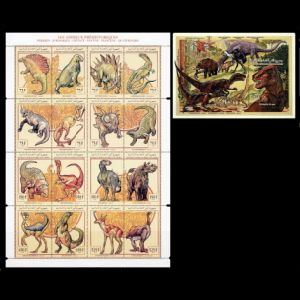
|
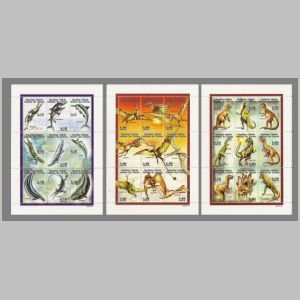
|
| 25.01.1999 "Prehistoric animals" | ||
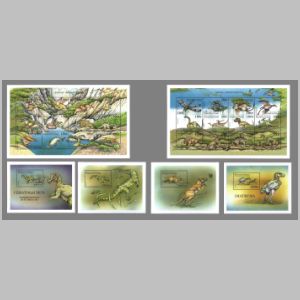
|
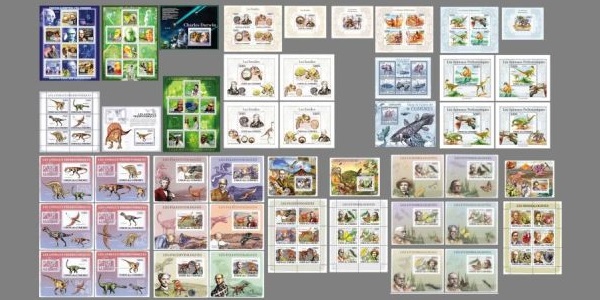
|
|
Notes:
[1] Part of set of 6 stamps and additional 7 blocks. Homo erectus is on the margin at the left bottom side.
Other stamps to consider: Latimeria/Coelacanth[A1] (living fossil)
| 20.09.1954 Latimeria (definitive stamp) | 20.09.1954 "Latimeria chalumnae" (Postage Due) | 30.04.1973 "Latimeria chalumnae" |
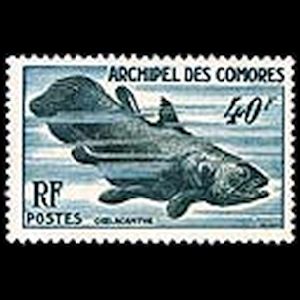 |
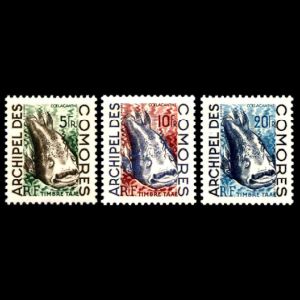 |
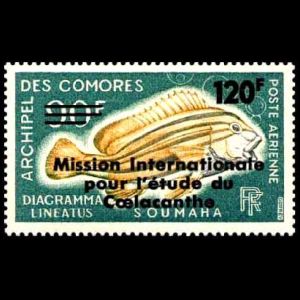 |
| 27.06.1975 "Coelacanth Expedition" | 01.08.1975 "Coelacanth Expedition" surcharged | 21.11.1977 "Fishes" |
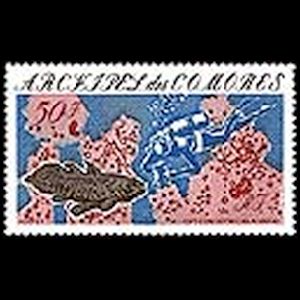 |
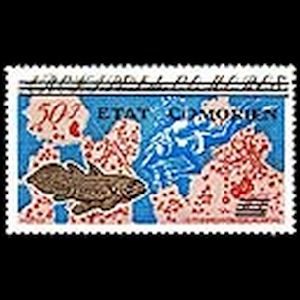 |
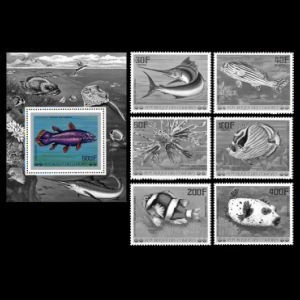 |
| 10.08.1998 "World Wildlife Fund (Latimeria chalumnae)" | 23.11.2005 "Diplomatic Relations with China" | |
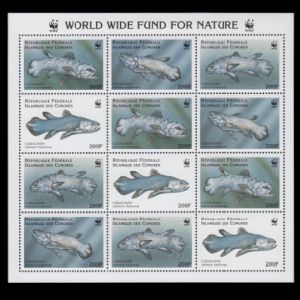 |
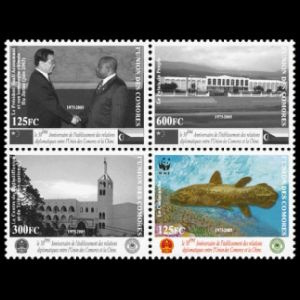 |

|
Notes:
[A1] On 20 February 1939, the stunning announcement was made that a Coelacanth (Latimeria) had been caught off the Chalumna River mouth near East London (a city in South Africa). At that time, the Coelacanth was thought to be extinct for nearly 70 million years. The drama commenced on 22 December 1938, when Capt H Goosen, skipper of the trawler Nenrine, brought ashore a peculiar metallic-blue, heavily-scaled fish with fins resembling legs. Miss Marjorie Courtenay-Latimer, Curator of the East London Museum, was informed of the strange catch, but was unable to identify the fish, which measured 1,5 m in length and weighed 57 kg. [R3] "Searching for African Coelacanths" exhibit of Susan Bahnick Jones explain the story of the "living fossil" discovery.
References:
- [R1] Comoros islands: Wikipedia, FlagCounter.
- [R2] Postal History and Philately of Comoros islands:
Wikipedia,
Links to official website of the Post Authority, stamp catalog and a list of new stamps of Comoros islands are here. - [R3] Coelacanth: Wikipedia, ENCYCLOPEDIA Britanica,
Acknowledgements:
Many thanks to Dr. Peter Voice from Department of Geological and Environmental Sciences, Western Michigan University, for the draft page review and his very valuable comments.
| << previous country | back to index | next country >> |